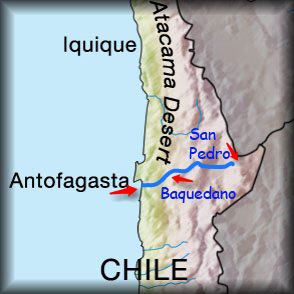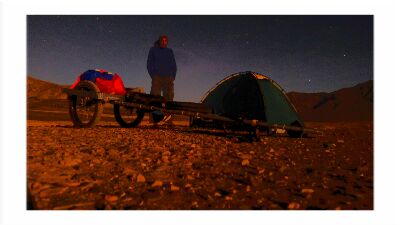
| start date | activity | country | place | from - to | days | km | km/ day | comment |
21.05.2013 |
organisation |
Chile |
Antofagasta |
3 |
40 |
13 |
assembling the desert cart |
|
24.05.2013 |
desert cart |
Ruta 5 |
Antofagasta - Baquedano |
2 |
83 |
41 |
along the highway |
|
26.05.2013 |
desert cart |
Atacama |
Baquedano - San Pedro de Atacama |
7 |
246 |
35 |
without support |
|
02.06.2013 |
resting |
San Pedro de Atacama |
1 |
0 |
0 |
|||
Total
| 13 |
369 |
28 |
|||||
 There is no water, either shade, tree, bush, or even the smallest plant, no bird, rodent, snake, not even the fly. But there are hot stones. So I'm in my field - the desert.
There is no water, either shade, tree, bush, or even the smallest plant, no bird, rodent, snake, not even the fly. But there are hot stones. So I'm in my field - the desert.
Atacama - whenever I heard this beautiful name, the thrills passed through me. Now I've had the good fortune and privilege of knocking on her door. Atacama let me in, she was rugged and mysterious, yet welcoming. In return I gave her respect and admiration. I was not afraid, I didn't stress about this trip - opposite, I was very excited. We discovered each other, learned and
cooperated. The desert can't be conquered, it's not the mountain, but you can enjoy the stay there or you can cross it.
 In Antofagasta for a few days I was assembling my desert cart and purchasing missing necessary equipment. Despite this I made two mistakes - I forgot to exchange pegs from summer to winter tent, and I didn't take spare spokes.
In Antofagasta for a few days I was assembling my desert cart and purchasing missing necessary equipment. Despite this I made two mistakes - I forgot to exchange pegs from summer to winter tent, and I didn't take spare spokes.
I decided it was worth a try to cross the desert in a classic sporty alpine style - without the use of hydrogen, unsupported from outside help and without playing with matches.
When I reached the town of Baquedano lying on the edge of the Atacama, I ate a good dinner, took 43 liters of water into six containers (2 large, 2 medium and 2 for direct use) and went into the sand. Well, not right away. For the entire first day dozens of trucks were passing me rushing to a number of mines here. Drivers wanted to help me with drinks, but at this stage I could not accept any help. True emptiness was waiting for me the next day.
 Usually the first few days of the new stage of the expedition I don't know where I have what in my luggage. With time the organization improves and most used items are in easy access, always in the same place.
Usually the first few days of the new stage of the expedition I don't know where I have what in my luggage. With time the organization improves and most used items are in easy access, always in the same place.
At this stage I couldn't reach the perfection of the packaging. This happened due the specificity of the cart. Weight must be distributed that way so the poles won't pressure me into the ground or not lifting me into the sky. Besides the wheel axle load should be balanced. And when the experiments started to work out, a few liters of water (an average of 4.5 liters per day) were gone daily, besides around one kilogram of food, disrupting all my work - almost every day I had to think new way and reorganize.
I get up before sunrise, I finishy day end after the sunset - the desert isn't to be played with, it's better to make the distance as soon as possible - to have enough water if something went wrong, such as cart broke up, loss of equipment, injury, etc. On the second day I was awakened by a light earthquake - what a feeling! Tent vibrated, everything was shaking, just a pity it was so short and weak.
 The Australian deserts are usually too hot to walk at afternoons - sweating require an increased demand for water. Here, even though it is hot, I just don't feel it as much. Perhaps the altitude (1000-3200m) or the cool wind, so at least I didn't take long lunch breaks. Nights were cold, the temperature dropped below zero - I was prepared for it with my new winter tent, sleeping bag, clothes and insulated inflatable mattress - it was warm and comfortable.
The Australian deserts are usually too hot to walk at afternoons - sweating require an increased demand for water. Here, even though it is hot, I just don't feel it as much. Perhaps the altitude (1000-3200m) or the cool wind, so at least I didn't take long lunch breaks. Nights were cold, the temperature dropped below zero - I was prepared for it with my new winter tent, sleeping bag, clothes and insulated inflatable mattress - it was warm and comfortable.
The first half of the way went quite smoothly. However, the eastern part was a different story. Mountains with canyons in which I lost orientation, I couldn't know in which direction the dry river beds are going, as they were winding like a stoned snake. I had to climb the nearby summits and look around. When I decided it was better to go to a neighboring canyon, the steep approach and loose sand was killing me with sinking wheels. Sometimes I wasn't able to pull up the cart - the total weight of 115 kg (cart 25 kg, spare parts and tools 11 kg, clothing and camping equipment 24 kg, food 12 kg, water, 43 kg).
 At one point I had enough of mountains. Unfortunately, I didn't have great maps (1:250 000), so I didn't know which way is the best. The worst was to walk the shortest way, the way I had planned - it turned out that crossing the dried-up river bed was physically too much demanding. I started learning how to use the topography to make my life easier. Finally I decided to go around the range and detour almost 30 km more - but the walk along the canyon was much easier and faster - without steep uphills and with a harder surface.
At one point I had enough of mountains. Unfortunately, I didn't have great maps (1:250 000), so I didn't know which way is the best. The worst was to walk the shortest way, the way I had planned - it turned out that crossing the dried-up river bed was physically too much demanding. I started learning how to use the topography to make my life easier. Finally I decided to go around the range and detour almost 30 km more - but the walk along the canyon was much easier and faster - without steep uphills and with a harder surface.
Roads, or rather 4WD trails, were very unpredicted. There were hundreds of them in each direction. It is remaining of the mining companies searching deposits of copper . Sometimes I walked happy like bank worker on Friday, when suddenly the road ends in the middle of nowhere. I had to walk in sandy wilderness and look for the better option.
 Sometimes I walked along the trail I was looking for not knowing about it, because you can't see it from several dozens meters. When exhausted by navigation I struggled up with another challenge, the encountered miners (I've seen drilling place or passing car usually once or twice per day) didn't hear about any canyon, I walked across the valley and in the end I saw a big crack in the ground - this was my wanted canyon. Once I have entered into it I didn't let it go like a dog his tasty chicken bone.
Sometimes I walked along the trail I was looking for not knowing about it, because you can't see it from several dozens meters. When exhausted by navigation I struggled up with another challenge, the encountered miners (I've seen drilling place or passing car usually once or twice per day) didn't hear about any canyon, I walked across the valley and in the end I saw a big crack in the ground - this was my wanted canyon. Once I have entered into it I didn't let it go like a dog his tasty chicken bone.
I must also admit that I was already with one leg into the grave. Literally. When I visited the ruins of an old mine, I rushed to the nearby burial ground. I really like the old cemetery - graves in huge mess, open wooden coffins, skeletons dressed in shreds of clothing. I took some pictures, some filming, with a slightly different perspective... crash, the ground beneath me broke off - old corrugated metal sheet covered with sand couldn't stand my weight - I landed with one leg into the grave next to the scary skeleton.
I had plenty of food and water - and yet quite rushing. I had an extra motivation - at the end of Moon Valley (beautiful surroundings of colorful eroded rocks), near the town of San Pedro de Atacama, I had something more then just a satisfaction of unsupport (from Baquedano to Valle de la Luna - 7 days, 234 km, 62% of paths and terrains, 2200 meters of altitude difference) traverse of the desert, but also there was Ewelina waiting for me, which I haven't seen for nearly four months. Our reunion in the middle of the road with tour bus doping was unique. Super!
| Country | Days | Food | (how many) paid accom. | Permits Entry fees |
Guide hire | Equipment purchase, hire |
Equipment or other freight fees | *Transport | Other | Total |
| Chile | 13 | $365 | (2) $32 | $0 | $0 | $134 | $151 | $0 | $50 | $732 |
